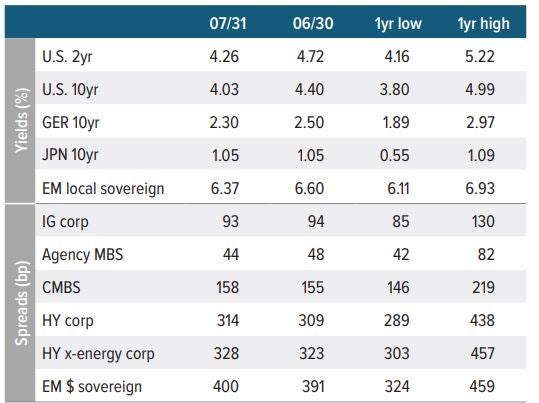
Whatever the exact cause of recent volatility, the more significant point is that it was an opportunity to add credit risk amid a positive outlook for underlying fundamentals.
Underweighting “risk”
Our portfolios entered the second half of the year largely underweight credit risk. Corporate bond spreads were at or near historical lows and with a variety of geopolitical events on the horizon (including an election in the U.S.) as well as uncertainty around the trajectory of economic growth, we expected a better entry point would arise.
On a relative-value basis, it was prudent to be underweight credit risk and keep some dry powder on hand to capitalize on opportunities. Accordingly, our theme #6 for the second half was to expect episodes of volatility:
“Seizing opportunities: Duration-oriented risks are poised to benefit from the implementation of central bank policy and the resulting decrease in rate volatility. Strong fundamentals will continue to support tight spreads, while periods of volatility spurred by expectations of lower growth and post-election policies changes will provide opportunities to episodically add risk.”
Volatility is a ladder
Given this investment theme, we entered the second half of the year with the view that periods of volatility would create opportunities to episodically add risk. Fast forward to July, when monthly data showed employers added just 114,000 jobs (35% fewer than expected) and unemployment rose to 4.3%, its highest level since October 2021. This, in part, caused a sharp selloff in risk assets, severe moves in rates and credit spread widening.
While market pundits continue to debate the exact cause of the extreme short-term volatility (there is speculation that the unwinding of leveraged trades added to the turbulence), the more significant point is that it was a buying opportunity. The spread widening in late July and early August created a more attractive entry point and we capitalized by modestly increasing our exposure to credit sectors and selectively adding idiosyncratic credit risk
Fundamentals remain strong
Importantly, nothing about the recent market volatility suggests that there is anything fundamentally wrong with the economy and corporate fundamentals. Despite recent weakness in the labor market, unemployment remains low by historical standards. And while income growth may have slowed, real household income remains elevated and higher than at any time prior to 2018. Coupled with a rising stock market and home price appreciation that has increased household net worth, consumers are wealthier in aggregate, and this will support consumption growth, albeit at a slower pace. Slower consumption also has a silver lining—it has brought Fed cuts into the picture, with positive implications for the cost of credit.
On the corporate side, EBITDA and net income growth are increasing, while ratings upgrades continue to outpace downgrades. That said, there are some cracks in the leveraged credit market, and we believe fundamentals could come under further pressure in a slower-growth environment. We are being highly selective about how we add credit risk at both the sector level and individual credit level.

As of 07/31/24. Sources: Bloomberg, JP Morgan, Voya IM. See disclosures for more information about indices. Past performance is no guarantee of future results.
Sector outlooks
Investment grade corporates
- Rate levels continue to be a key driver of investment grade spreads, with yield-based investors swinging from buyers to sellers depending on the level of rates.
- Quarterly earnings continue to exceed analyst estimates with companies in communication services, information technology, financials, utilities, health care, and consumer discretionary reporting double digit growth in aggregate.
- New issuance continues to be above average but trending down from the higher levels earlier in 2024, which provided some relief on the technical side.
- From a positioning standpoint, we remain overweight financials, BBBs and the 10-year part of the curve.
High yield corporates
- Overall spread widening was limited in July as the CCC rated issuers that underperformed in June rebounded strongly in July.
- We continue to see signs of slowing growth in both macro and micro data, which threatens the strong top-line performance that has supported credit in recent quarters.
- From a positioning standpoint, we are overweight food/beverage, healthcare/pharma, energy and chemicals, although we began to reduce our exposure to chemicals. We are underweight technology, as well as media/telecom companies with structurally challenged business models.
Senior loans
- While senior loans posted a positive return in July, the sector underperformed other fixed income asset classes and equities, as high yield bonds and investment grade posted strong gains.
- As earnings season approaches its end, we are paying close attention to segments in consumer services for further evidence of continued deceleration given the guidance revisions we’re seeing in some sectors, particularly airlines, hotels, autos, and manufacturers.
- Despite the outperformance of B and CCC rated loans this year, we continue to remain cautious on B-/CCC cohorts until we get further clarity on macro, geopolitical developments, monetary policy, fundamentals and earnings trajectory.
Agency mortgages
- Overall, we expect fundamentals and technicals to support mortgage returns for the remainder of 2024.
- However, in the short term, the performance of agency mortgages will be closely correlated with overall volatility and rate directionality.
- Mortgages have recently outperformed, but spreads remain within the fair range for most cohorts.
Securitized credit
- Amid a landscape of robust securitized issuance and, on balance, supportive macroeconomic environment, the securitized credit market is demonstrating resilience, buoyed by the relative strength of U.S. consumers and initial repair in commercial real estate.
- ABS issuers are monetizing strong investor demand as the pace of new issuance has hit historically high levels. The “harmony” between issuers and investors has created a virtuous cycle of reliable primary market execution, inspiring more issuance which attracts more capital, reinforcing stable risk/ return opportunities. Crucially, underwriting quality has been strong against the later stage economic backdrop, aiding in keeping the virtuous cycle intact.
- After a long streak of outperformance, CLOs are more vulnerable to falling rates and slower economic growth, with the sector facing potentially imminent headwinds from the Fed reducing rates and the feed through into lower CLO base rates (3-month SOFR).
- Improved financial conditions have helped reduce the crisis like spread premiums once available in CMBS, effectively reducing “easy money” opportunities. As remaining problem loans continue to resolve, collateral based security selecting will slowly but surely replace simply asset allocating to the sector and “buying the sector.”
- Residential-mortgage credit behavior is set up to remain insulated from a modest decline in home prices. Average mortgage rates for existing homeowners are <4% and the buffer of homeowners’ equity remains at or near historical highs. In our view, any spread widening inspired by potential housing weakness would constitute a buying opportunity.
Emerging market debt
- While the emerging market (EM) growth outlook is modest, risks are skewed to the downside.
- EM fiscal and debt metrics have not recovered to their pre-pandemic levels, and markets have shown a greater sensitivity to negative surprises.
- Corporate fundamentals overall remain resilient and financial policy remains prudent. Corporate default rates are expected to be lower due to less defaults in Asia and Europe
A note about risk
The principal risks are generally those attributable to bond investing. All investments in bonds are subject to market risks as well as issuer, credit, prepayment, extension, and other risks. The value of an investment is not guaranteed and will fluctuate. Market risk is the risk that securities may decline in value due to factors affecting the securities markets or particular industries. Bonds have fixed principal and return if held to maturity but may fluctuate in the interim. Generally, when interest rates rise, bond prices fall. Bonds with longer maturities tend to be more sensitive to changes in interest rates. Issuer risk is the risk that the value of a security may decline for reasons specific to the issuer, such as changes in its financial condition.

